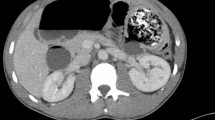Abstract
Background and aims
The objective of this study was to present the etiology, clinical presentation, diagnosis, and management for 14 cases of gossypiboma [retained surgical sponge (RSS)] treated at a single center and to emphasize the importance of this potential complication.
Methods
Data for 14 cases of RSS treated between January 1999 and December 2004 were retrospectively assessed. The details of preoperative evaluation, demographic features, and operative findings were recorded. Use of, and findings from, abdominal x-ray, ultrasonography, computed tomography, magnetic resonance imaging, and upper-gastrointestinal endoscopy were also noted.
Results
In all cases, the RSS was surgically removed. Thirteen of the 14 patients were symptomatic, and the most frequent finding was nonspecific abdominal pain and intestinal obstruction. Four patients required urgent surgery because the sponges were causing intestinal obstruction or intraabdominal sepsis. Based on history, physical examination findings, and diagnostic imaging, RSS was diagnosed preoperatively in five of the patients. Postoperative complications, including surgical site infection and evisceration, occurred in five cases.
Conclusion
RSS can lead to significant medical and legal problems between the patient and the doctor. RSS may be incorrectly diagnosed preoperatively, which can lead to unnecessary invasive diagnostic procedures and operations. Strict measures must be taken to prevent this complication.



Similar content being viewed by others
References
Moyle H, Hines OJ, McFadden DW (1996) Gossypiboma of the abdomen. Arch Surg 131:566–568
Jain M, Sawhney S (1995) Gossypiboma: ultrasound-guided removal. J Clin Ultrasound 23:321–323
Lauwers PR, Hee RHV (2000) Intraperitoneal gossypiboma: the need to count sponges. World J Surg 24:521–527
Kaiser CW, Freidman S, Spurling KP, Slowick T, Kaiser HA (1996) The retained surgical sponge. Ann Surg 224:79–84
Gawende AA, Studder DM, Orav EJ et al (2003) Risk factors for retained instruments and sponges after surgery. N Engl J Med 348:229–235
Serra J, Matias-Guiu X, Calabuig R, Garcia P, Sancho FJ, Calle JPL (1988) Surgical gauze pseudotumor. Am J Surg 155:235–237
Hyslop JW, Maull KI (1982) Natural history of the retained surgical sponge. South Med J 75:657–660
Gonzales-Ojeda A, Rodriguez-Alcantar DA, Arenas-Marquaz H (1999) Retained foreign bodies following intraabdominal surgery. Hepatogastroenterology 46:808–812
Rappaport W, Haynes K (1990) The retained surgical sponge following intra-abdominal surgery. Arch Surg 125:405–407
Sturdy JH, Baird RM, Gerein AN (1967) Surgical sponges: a cause of granuloma and adhesion formation. Ann Surg 165:128–134
Zbar AP, Agrawal A, Saeedi IT, Utidjian MRA (1998) Gossypiboma revisited: a case report and review of the literature. J R Coll Surg Edinb 43:417–418
Cihan A, Mentes B, Tascılar O, Kathan B, Ucan B, Yılmaz E, Gorgul A (1997) Surgical gauze pseudotumor eroding into the intestine. Gazi Med J 8:122–125
Richards WO, Keramatı B, Scovill WA (1986) Fate of retained foreign bodies in the peritoneal cavity. South Med J 79:496–498
Lin TY, Chuang CK, Wong YC, Liao HC (1999) Gossypiboma: migration of retained surgical gauze and spontaneous transurethral protrusion. BJU Int 84:879–880
Coche G (1988) Ultrasonography and x-ray computed tomography in the diagnosis of intraabdominal textiloma. Apropos of 12 cases. J Radiol 69:243–251
Sugano S, Suzuki T, Iinuma M, Mizugami H, Kagesawa M, Ozawa K et al (1993) Gossypiboma: diagnosis with ultrasonography. J Clin Ultrasound 21:289–292
Sugimura H, Tamura S, Kakitsubata Y, Kakaitsubata S, Uwada O, Kihara Y, Nagatomo M, Watanabe K (1992) Magnetic resonance imaging of retained surgical sponge. Case report. Clin Imaging 16:259–262
Uranus U, Schauer C, Pfeifer J et al (1995) Laparoscopic removal of a large laparotomy pad forgotten in situ. Surg Laparosc Endosc 5:77–79
Author information
Authors and Affiliations
Corresponding author
Rights and permissions
About this article
Cite this article
Yildirim, S., Tarim, A., Nursal, T.Z. et al. Retained surgical sponge (gossypiboma) after intraabdominal or retroperitoneal surgery: 14 cases treated at a single center. Langenbecks Arch Surg 391, 390–395 (2006). https://doi.org/10.1007/s00423-005-0581-4
Received:
Accepted:
Published:
Issue Date:
DOI: https://doi.org/10.1007/s00423-005-0581-4




